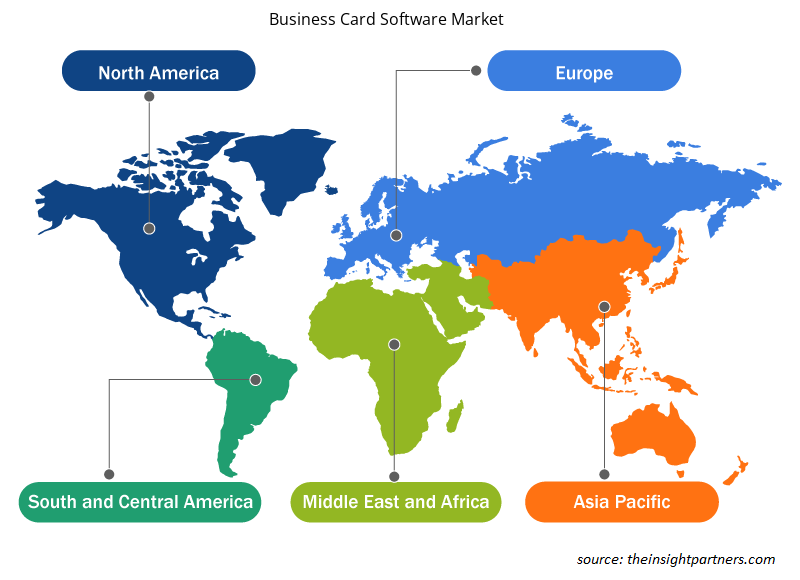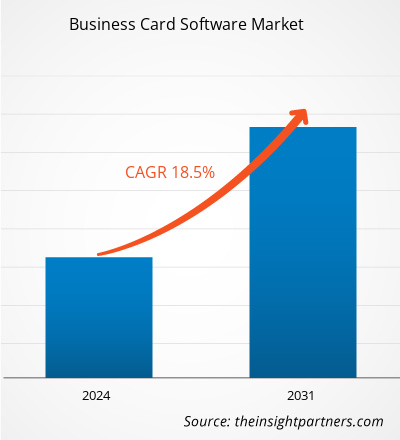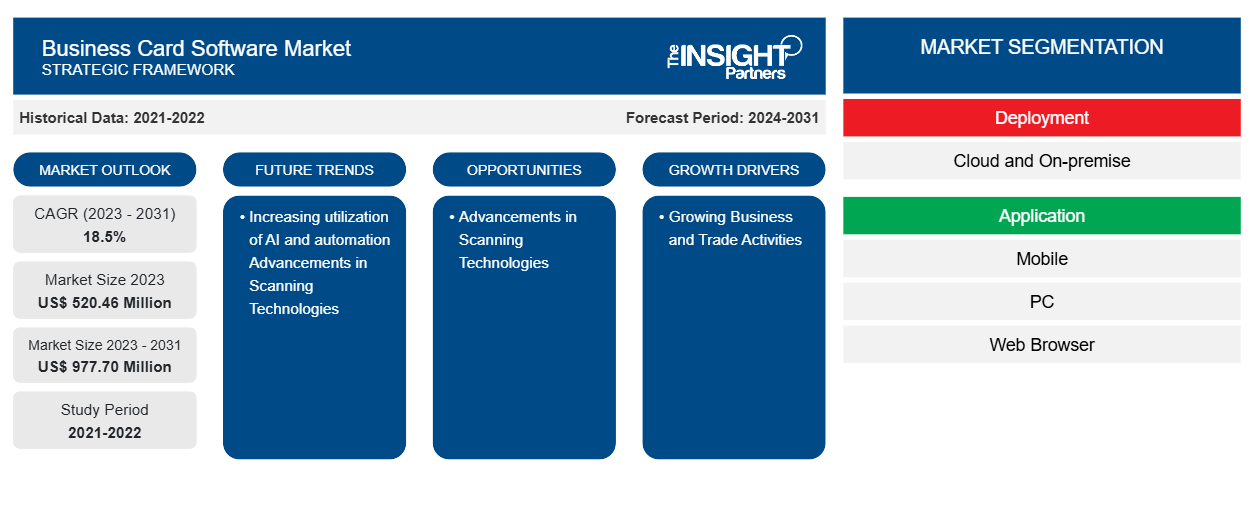Der globale Markt für Visitenkartensoftware soll von 520,46 Millionen US-Dollar im Jahr 2023 auf 977,70 Millionen US-Dollar im Jahr 2031 wachsen; von 2023 bis 2031 wird eine durchschnittliche jährliche Wachstumsrate von 18,5 % erwartet. Die zunehmende Nutzung von KI und Automatisierung dürfte ein wichtiger Trend auf dem Markt für Visitenkartensoftware bleiben.
Marktanalyse für Visitenkartensoftware
Die Einführung verbesserter intelligenter Scantechnologien hat die Nachfrage nach Software zur Verwaltung des Scannens von Visitenkarten erhöht. Verbraucher wenden sich von traditionellen Visitenkarten aus Papier ab und digitalen Alternativen zu, was die Umsatzentwicklung in diesem Marktsektor ankurbelt.
Marktübersicht für Visitenkartensoftware
Visitenkartensoftware ist ein leistungsstarkes Tool, das die Art und Weise verändert, wie Fachleute ihre Kontaktinformationen verwalten. Dieses Programm wurde unter Berücksichtigung der aktuellen Geschäftsumgebung entwickelt und vereinfacht den Prozess des Entwerfens, Organisierens und Austauschens von Visitenkarten, verbessert die Netzwerkfähigkeiten und fördert die Markenkonsistenz. Mit der Visitenkartensoftware können Fachleute mühelos ihre eigenen Visitenkarten entwerfen und personalisieren. Das Programm bietet eine Vielzahl von Vorlagen und Gestaltungsmöglichkeiten, sodass Benutzer optisch ansprechende und professionell aussehende Karten erstellen können, die zu ihrer Corporate Identity passen. Ob es um die Auswahl von Schriftarten, Farben oder Logos geht, das Programm verfügt über eine einfache Benutzeroberfläche, mit der Benutzer problemlos einzigartige Visitenkarten entwerfen können, die einen bleibenden Eindruck hinterlassen.
Passen Sie diesen Bericht Ihren Anforderungen an
Sie erhalten kostenlos individuelle Anpassungen an jedem Bericht, einschließlich Teilen dieses Berichts oder einer Analyse auf Länderebene, eines Excel-Datenpakets sowie tolle Angebote und Rabatte für Start-ups und Universitäten.
-
Holen Sie sich die wichtigsten Markttrends aus diesem Bericht.Dieses KOSTENLOSE Beispiel umfasst eine Datenanalyse von Markttrends bis hin zu Schätzungen und Prognosen.
Treiber und Chancen auf dem Visitenkartensoftwaremarkt
Wachsende Geschäfts- und Handelsaktivitäten begünstigen den Markt
Es wird erwartet, dass die Verkaufszahlen von Visitenkartensoftware mit der Ausweitung der globalen Geschäfts- und Handelsaktivitäten sprunghaft ansteigen werden. Diese Expansion ist besonders in Regionen wie Nordamerika, Europa und Asien-Pazifik spürbar, die über technologisch hochentwickelte Volkswirtschaften und einen erheblichen Bedarf an Visitenkartensoftware verfügen. Darüber hinaus haben die Globalisierung der Märkte und der technologische Fortschritt erheblich zur Ausweitung der Handels- und Handelsaktivitäten beigetragen. Die Technologie hat Kommunikation, Transport und Reisen proletarisiert, sodass abgelegene Gebiete und mittellose Menschen die Anziehungskraft der Moderne spüren. Dies hat zu einer steigenden Nachfrage nach Visitenkartensoftware geführt, da Unternehmen versuchen, ihre Produkte an die Anforderungen neuer Märkte anzupassen.
Fortschritte in der Scan-Technologie
Das Aufkommen moderner intelligenter Scantechnologien hat die Nachfrage nach Software zur Verwaltung des Scannens von Visitenkarten tatsächlich angeheizt. Dieser Wandel wird durch den Umstieg der Verbraucher von traditionellen Visitenkarten aus Papier auf digitale Äquivalente vorangetrieben, was zu einem Wachstum des Marktsegments für Anwendungen zum Scannen von Visitenkarten geführt hat. Mit Anwendungen zum Scannen von Visitenkarten können Unternehmen Visitenkarten mithilfe einer Smartphone-Kamera scannen. Diese Anwendungen nutzen die Technologie der optischen Zeichenerkennung (OCR), um die Informationen automatisch von der Karte zu extrahieren und im Telefon des Benutzers zu speichern. Die gescannten Karten werden dann in digitale Kontakte umgewandelt, die in einem virtuellen Adressbuch gespeichert werden, was eine einfache Verwaltung und Organisation ermöglicht.
Marktbericht zur Visitenkartensoftware – Segmentierungsanalyse
Wichtige Segmente, die zur Ableitung der Marktanalyse hinsichtlich Einsatz und Anwendung von Visitenkartensoftware beigetragen haben.
- Basierend auf der Bereitstellung ist der Markt in On-Premises und Cloud unterteilt. Das Cloud-Segment hatte im Jahr 2023 einen größeren Marktanteil.
- Basierend auf der Anwendung ist der Markt in Mobilgeräte , PCs und Webbrowser unterteilt. Das Webbrowser-Segment hatte im Jahr 2023 einen größeren Marktanteil.
Marktanteilsanalyse für Visitenkartensoftware nach geografischer Lage
Der geografische Umfang des Marktberichts für Visitenkartensoftware ist hauptsächlich in fünf Regionen unterteilt: Nordamerika, Asien-Pazifik, Europa, Naher Osten und Afrika sowie Südamerika/Süd- und Mittelamerika. Nordamerika dominierte den Markt für Visitenkartensoftware im Jahr 2023. Der Markt für Visitenkartensoftware in Nordamerika verzeichnet aufgrund der zunehmenden Digitalisierung von Geschäftsprozessen ein erhebliches Wachstum. Fachleute setzen auf digitale Netzwerk- und Kontaktverwaltungslösungen, um ihre Abläufe zu optimieren. Die weit verbreitete Nutzung von Smartphones und Mobilgeräten hat die Nachfrage nach mobilfreundlichen Visitenkarten-Apps weiter angeheizt. Darüber hinaus benötigen Unternehmen eine nahtlose Integration dieser Software mit anderen Tools wie CRM-Software, um die Effizienz bei der Vernetzung und Datenorganisation zu steigern. Infolgedessen besteht auf dem nordamerikanischen Markt ein wachsender Bedarf an fortschrittlicher und benutzerfreundlicher Visitenkartensoftware.
Regionale Einblicke in den Markt für Visitenkartensoftware
Die regionalen Trends und Faktoren, die den Markt für Visitenkartensoftware im Prognosezeitraum beeinflussen, wurden von den Analysten von Insight Partners ausführlich erläutert. In diesem Abschnitt werden auch die Marktsegmente und die Geografie von Visitenkartensoftware in Nordamerika, Europa, im asiatisch-pazifischen Raum, im Nahen Osten und Afrika sowie in Süd- und Mittelamerika erörtert.

- Erhalten Sie regionale Daten zum Markt für Visitenkartensoftware
Umfang des Marktberichts zur Visitenkartensoftware
| Berichtsattribut | Details |
|---|---|
| Marktgröße im Jahr 2023 | 520,46 Millionen US-Dollar |
| Marktgröße bis 2031 | 977,70 Millionen US-Dollar |
| Globale CAGR (2023 - 2031) | 18,5 % |
| Historische Daten | 2021-2022 |
| Prognosezeitraum | 2024–2031 |
| Abgedeckte Segmente |
Nach Bereitstellung
|
| Abgedeckte Regionen und Länder |
Nordamerika
|
| Marktführer und wichtige Unternehmensprofile |
|
Marktteilnehmerdichte: Der Einfluss auf die Geschäftsdynamik
Der Markt für Visitenkartensoftware wächst rasant. Dies wird durch die steigende Nachfrage der Endnutzer aufgrund von Faktoren wie sich entwickelnden Verbraucherpräferenzen, technologischen Fortschritten und einem größeren Bewusstsein für die Vorteile des Produkts vorangetrieben. Mit der steigenden Nachfrage erweitern Unternehmen ihr Angebot, entwickeln Innovationen, um die Bedürfnisse der Verbraucher zu erfüllen, und nutzen neue Trends, was das Marktwachstum weiter ankurbelt.
Die Marktteilnehmerdichte bezieht sich auf die Verteilung der Firmen oder Unternehmen, die in einem bestimmten Markt oder einer bestimmten Branche tätig sind. Sie gibt an, wie viele Wettbewerber (Marktteilnehmer) in einem bestimmten Marktraum im Verhältnis zu seiner Größe oder seinem gesamten Marktwert präsent sind.
Die wichtigsten auf dem Markt für Visitenkartensoftware tätigen Unternehmen sind:
- ABBY
- Adobe
- Mojosoft
- CAM-Entwicklung
- DRPU SOFTWARE PVT. LTD
- Heuhaufen
Haftungsausschluss : Die oben aufgeführten Unternehmen sind nicht in einer bestimmten Reihenfolge aufgeführt.

- Überblick über die wichtigsten Akteure auf dem Markt für Visitenkartensoftware
Neuigkeiten und aktuelle Entwicklungen zum Markt für Visitenkartensoftware
Der Markt für Visitenkartensoftware wird durch die Erhebung qualitativer und quantitativer Daten nach Primär- und Sekundärforschung bewertet, die wichtige Unternehmenspublikationen, Verbandsdaten und Datenbanken umfasst. Im Folgenden finden Sie eine Liste der Entwicklungen auf dem Markt:
- Im August 2022 kündigte Adobe Verbesserungen an seinem Adobe Cloud Document an, darunter Erweiterungen für Adobe Scan, Adobe Sign und die Integration mit Microsoft 365. Diese Integration ermöglicht es Benutzern, hochwertige, sichere PDFs direkt in Microsoft 365-Anwendungen zu erstellen, zu bearbeiten und anzuzeigen.
(Quelle: Adobe, Pressemitteilung, 2022)
Marktbericht zu Visitenkartensoftware – Umfang und Ergebnisse
Der Bericht „Marktgröße und Prognose für Visitenkartensoftware (2021–2031)“ bietet eine detaillierte Analyse des Marktes, die die folgenden Bereiche abdeckt:
- Marktgröße und Prognose auf globaler, regionaler und Länderebene für alle wichtigen Marktsegmente, die im Rahmen des Projekts abgedeckt sind
- Marktdynamik wie Treiber, Beschränkungen und wichtige Chancen
- Wichtige Zukunftstrends
- Detaillierte PEST/Porters Five Forces- und SWOT-Analyse
- Globale und regionale Marktanalyse mit wichtigen Markttrends, wichtigen Akteuren, Vorschriften und aktuellen Marktentwicklungen
- Branchenlandschaft und Wettbewerbsanalyse, einschließlich Marktkonzentration, Heatmap-Analyse, prominenten Akteuren und aktuellen Entwicklungen
- Detaillierte Firmenprofile
- Historische Analyse (2 Jahre), Basisjahr, Prognose (7 Jahre) mit CAGR
- PEST- und SWOT-Analyse
- Marktgröße Wert/Volumen – Global, Regional, Land
- Branchen- und Wettbewerbslandschaft
- Excel-Datensatz
Aktuelle Berichte
Verwandte Berichte
Erfahrungsberichte
Grund zum Kauf
- Fundierte Entscheidungsfindung
- Marktdynamik verstehen
- Wettbewerbsanalyse
- Kundeneinblicke
- Marktprognosen
- Risikominimierung
- Strategische Planung
- Investitionsbegründung
- Identifizierung neuer Märkte
- Verbesserung von Marketingstrategien
- Steigerung der Betriebseffizienz
- Anpassung an regulatorische Trends























 Kostenlose Probe anfordern für - Markt für Visitenkartensoftware
Kostenlose Probe anfordern für - Markt für Visitenkartensoftware